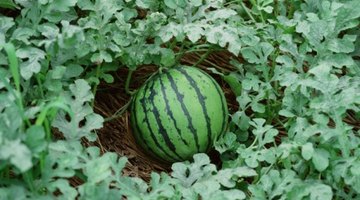Melon Vine Identification
Table of Contents
Melons are members of the Cucurbitaceae family, a botanical clan also including cucumbers, squashes, pumpkins and gourds. Unlike their cousin cucurbits, melons tend to be sweeter, and are eaten as fruits rather than vegetables. The bitter melon, used as a vegetable in Asian cuisine, may be the exception.

There are several distinct types of melons, each with their own particular qualities and features.
Cantaloupe
Cantaloupes (Cucumis melo) are indigenous to Egypt. These vines reach mature lengths of up to 10 feet, bearing broad, vaguely heart-shaped green leaves with ruffled edges. Like many melons, cantaloupe vines and their leaves are somewhat fuzzy to the touch. In summer, these climbing vines produce sunshine-yellow, five-petaled flowers, which give way to large, round fruit. These fruit are covered in a greenish taupe-colored, mesh-textured rind and contain sweet, juicy, light orange flesh. A mass of pale, oval seeds reside at the center of each ripe cantaloupe. Cantaloupe vines are hardy in U.S. Department of Agriculture growing zones 4 to 10, a region including much of the southern and central United States. They enjoy full sun and minimum temperatures of 70 degrees Fahrenheit.
Watermelon
The watermelon plant (Citrullus lanatus), native to Africa, grows 10 to 16 feet in length. It bears hairy, vibrant green, deeply-lobed leaves. Its bright yellow, five-petaled, warm-season flowers, greatly resemble those of the cantaloupe vine. These flowers give way to large, oblong melons with smooth, striped light and dark green rinds containing juicy pink flesh embedded with dark brown, flat teardrop-shaped seeds. Watermelons are grown as a summer crop in zones 3 to 9. They flourish in full sun and require abundant water. Like cantaloupe vines, watermelons prefer air temperatures exceeding 70 degrees Fahrenheit.
Honeydew
Like the cantaloupe, the honeydew melon is a member of the species Cucumis melon. This vine grows up to 10 feet long, with large, furry, slightly angular, heart-shaped leaves. Its buttery blossoms are similar to those of cantaloupe and watermelon, yet have petals possessing a wrinkled appearance. The melons of this vine are a little larger than cantaloupes, with a smooth, pale green rind containing mild-flavored, light green flesh. Honeydew vines thrive in acidic soils in full sun. They need a good amount of water, yet water on their leaves can lead to powdery mildew infection. They are hardy in zones 3 to 10.
Bitter Melon
The bitter melon (Momordica charantia) is an unusual melon vine. In its native China, where is known as Ku-gua, it is grown both as a vegetable and an ornamental plant. This plant resembles a slender cucumber vine, bearing yellow flowers which give way to cylinder-shaped melons. These melons grow to lengths of 8 inches and diameters of 2 inches. They are covered in bumpy, shiny green skin and pale, cooling, bittersweet flesh.
Horned Melon
Another exotic melon vine is the horned melon (Cucumis metuliferus), also known as the African horned melon or kiwano. Like the watermelon, it originated on the African continent. Horned melon vines grow 5 to 10 feet long, with an angular, hairy stem and a curling tendril every 2 to 3 inches down the vine. It bears small, five-lobed leaves. Its melons are only 2 to 4 inches long when fully grown, with a bright yellow and orange, spiky rind covering gelatinous, lime green flesh. These unique melons grow best in hot, dry conditions.
The Drip Cap
- Melons are members of the Cucurbitaceae family, a botanical clan also including cucumbers, squashes, pumpkins and gourds.
- Like many melons, cantaloupe vines and their leaves are somewhat fuzzy to the touch.
- Watermelons are grown as a summer crop in zones 3 to 9.
- They flourish in full sun and require abundant water.
- The melons of this vine are a little larger than cantaloupes, with a smooth, pale green rind containing mild-flavored, light green flesh.
- The bitter melon (Momordica charantia) is an unusual melon vine.
- It bears small, five-lobed leaves.
- Its melons are only 2 to 4 inches long when fully grown, with a bright yellow and orange, spiky rind covering gelatinous, lime green flesh.
Resources
Writer Bio
Tara Cochrane has been writing nonfiction essays and articles since 1999. She worked as a writer for Cosmic Patterns Software, where she created content concerning various topics in astrology. Her work is included in the Sirius astrology software program. Cochrane earned a Bachelor of Fine Arts in studio art from Florida State University.
Photo Credits
- Jupiterimages/Photos.com/Getty Images
- Jupiterimages/Photos.com/Getty Images
More Articles



